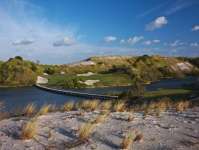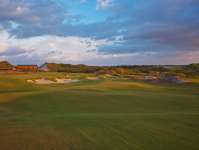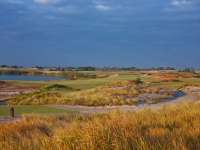Despite its relative youth, the story of the Streamsong Resort is already well known throughout golfing circles. The resort was conceived and developed by The Mosaic Company, America’s largest producer of phosphate fertilizer, as a means of reclaiming a mine site in central Florida for the purposes of recreation. That site is set in a somewhat secluded corner of Polk County many miles from the coastline but with an abundance of the precise ingredients necessary for great golf, sand and undulation.
Aside from the fact that sandy, undulating sites in Florida are rare, what’s most unique about Streamsong are the processes of design as well as the process of reclamation. The area where both Blue and Red Courses were built was comprised, mostly, of a series of dune ridges created by mining spoil many decades earlier. These ridges, as well as the land between, are essentially pure sand, left on the ground once the phosphate had been dug out and removed. As mining pits evolved over years to appear as naturally forming lakes and ponds, so too were the dunes naturalized by father time. Native ground vegetation sprung up to stabilize the structures and ultimately help persuade the developer of their suitability for links golf.
Once a decision was made by management to reclaim the area for recreation and erect a golf resort on the site, the design decision became crucial. For a sandy, linkslike site to compete with a Bandon Dunes on the West Coast or the many great offerings in Scotland, Ireland and England, the golf would need to be world-class. Enter Tom Doak and Bill Coore, the most acclaimed course designers of the modern era. Doak and Coore have several courses in close proximity around the world but had never worked together on a routing before this project. Interestingly, the Blue and Red courses were named for the color pens used to delineate holes on their collaborative layout plan.
Once the routings were finalized, Doak chose to design the Blue layout and Coore the Red, in part because the opening sequence of holes occupied land that had not yet been reclaimed from the mining operations. He had more flexibility, therefore, to craft, or at least suggest, how some of his landforms were created. Doak’s Blue Course land, by contrast, was more established and his holes set mostly through the interior of the property.
As much as the subtle stylistic differences between the two minimalist designers, what separates the courses at Streamsong are the landforms. Coore’s Red Course features a more attractive set of sand dunes and more abrupt elevation changes around the periphery. Doak’s course approaches a couple of large dunes but generally has softer external shapes and a more intimate routing, with holes doubling back more frequently into communal green and tee areas. His opening tee is placed atop the tallest dune on the property, from where you can see most of the 36 holes as well as the principal spoil lake and clubhouse. It’s an exciting view, if somewhat taxing start to the round.
Blue Course
While Doak’s Blue Course mostly occupies the interior of the Streamsong property, like the Red Course it is essentially arranged in two uneven loops. The first six holes play out and back toward the principal dune and the remaining 12 are largely set in a ring around the outside of that opening stretch. The Blue Course’s most memorable hole is certainly the par three 7th, which follows an excellent short par four played toward the giant dune ridge upon which the elevated 1st tee is set. The anticipation of playing the 7th is heightened by the clear view you get from around the clubhouse and 1st tee areas. The hole doesn’t disappoint, the beauty of the dune amphitheatre setting matched by striking bunkers cut into the vegetation and by Doak’s elegant putting contours.
Streamsong Blue is far from a one-hole wonder, but in some ways the 7th sucks oxygen away from other holes in the general area. The next few are certainly all solid, though unlikely to linger as long in the memory bank or dominate post-round analysis of the course. Controversial greens like the 9th, 11th and 14th may feature in discussions, but aside from the 7th most of the standout areas here are found early or late in the round.
Our favorites include the rippled 3rd fairway, the terrific approach across a bunkered ridge into the 4th green and the blind-over-a-bump second shot into the par four 15th hole. The sunken front section of the excellent par five 17th green is also very cool. As is Doak’s rising and falling par four finishing hole, one of his best closers and played toward a shallow dell green protected by some clever bunkering short of the putting surface. Best through the middle section is the short par four 13th hole, a less severe version of the famous 6th at Pacific Dunes, and the well bunkered 12th with its attractive tiered target. The crested drive on the par five 9th is another highlight.
Given the design pedigree and proximity of the two courses at Streamsong, comparisons between them were always inevitable. Golfers will have their own preferences and our sense is that those who prefer the Blue are unlikely to dislike the Red, whereas some of the those who lean toward Red are probably not fond at all of the Blue. This is likely due to the more aggressively contoured greens on Doak’s course, and the fact that some of the severe target areas are quite small and seemingly set to repel, rather than accept, the approaching ball. There is also no doubt that the Red Course occupies more attractive terrain.
Regardless of your take, both Red and Blue are full of great ground undulations and the sort of exciting, strategic linkslike fairways and greens that have come to symbolize Coore and Doak’s respective design careers. The fact that two high-quality courses like this sit side by side makes Streamsong unique in America, and the ideal place for those looking at a short-to-medium term golf getaway.

 this course also has exceptional:
this course also has exceptional:



